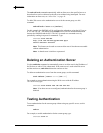
Authentication
TUT Systems, Inc Page 49 of 104 P/N 220-06288-20
HTTP Request Throttle
Setting the HTTP Request Throttle
Use the set http-request throttle command to configure a per-session throttle on the rate
at which HTTP requests from that session are handled before authentication. A new
session begins with max_requests requests enabled. Every request uses one from a pool
of available requests until there are no requests available in the pool. Requests are
allocated to the session at request_rate requests per second.
Note:
This command has no effect on authenticated subscribers.
To configure a per session throttle on the rate at which HTTP requests from that session
are handled before authentication, use this command:
set http-request-throttle max_requests [request_rate]
For example, to enable an HTTP request throttle for each unauthenticated session,
starting with 10 requests, and with requests available to that session at one request per
second, use:
sms2000% set http-request-throttle 10 1
If the subscriber generates 11 HTTP requests in less than one second, it is ignored. After
using all available requests, only 1 request per second is handled and additional requests
are ignored.
Deleting the HTTP Request Throttle
To disable the HTTP request throttle for sessions not yet authenticated, use this
command:
delete http-request-throttle
For example to turn off the HTTP throttle request setting, type:
sms2000% delete http-request-throttle
Allow-Nets
Allow-nets provide single IP addresses or subnets to which subscribers can send IP data
without authentication, the set allow-net command supports up to 1000 allow-nets.
Beginning with the release of SMS2.3.6, Allow-Nets support DNS names as well as IP
addresses.


















